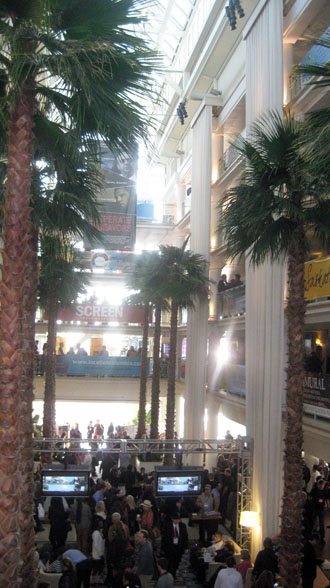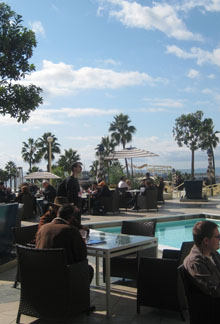 I went to the American Film Market with my documentary, Bare Hands and Wooden Limbs, in search of a distributor. But I also had a burning question on my mind: is a film market like AFM a place for a writer, especially a writer without representation and without a package in development?
I went to the American Film Market with my documentary, Bare Hands and Wooden Limbs, in search of a distributor. But I also had a burning question on my mind: is a film market like AFM a place for a writer, especially a writer without representation and without a package in development?
In the end I decided that AFM is not a place for writers who are hoping to find representation or a producer. If you are in that situation a pitchfest might be a better place, or going to festivals where your script has placed well in a contest. But if you are a writer AND a producer putting together a package or get some pre-sales from foreign territories, then AFM is the place for you. And keep in mind that you don’t actually have to attend AFM to benefit from it.
The first thing to consider about AFM is the cost. If you don’t live in or near LA you have to fly there, then get a hotel – preferably in Santa Monica, since AFM provides a full day of conferences, then the market, screenings, cocktail parties, more screenings, and after parties. But hotel prices during AFM are higher than usual and everything sells out fast.
There are two ways of attending AFM. You can attend the full ten days, or you can attend the last five or even four days of the market. Unless you are a professional sales agent, there isn’t much reason to attend the whole ten days.
If you attend the last five days, your ticket (much cheaper than a full market ticket) gives you admittance to the AFM Conference series: the Pitch conference, the Marketing conference, the Production conference and the Distribution conference. A Finance conference meets a day earlier but to attend you have to pay an extra fee. I did that and found most of it unsuitable for indie filmmakers; rather it was financiers talking to each other. Many people in the audience were investors and bankers who were looking to get out of real estate and into film. The fact that film, at least this year, is seen as a safer investment ought to bode well for indie filmmakers.

The other conferences were instructive, but I felt that I have gotten that instruction elsewhere, such as at the IFP Conference in New York and /or at various festivals around the country. The pitching conference was very instructive. It was moderated by Stephanie Palmer, the author of “Good in a Room,” and a handful of filmmakers pitched to two real producers, Tobin Armbrust of Exclusive Media Corp, and Cassian Elwes, and independent producer who just made the movie Margin Call.
In order to benefit fully from your AFM experience, you need to sign up for it early, months before the AFM actually takes place, which is also the best time to get a hotel room at a nearby hotel. You also sign up then for the online networking space MyAFM, which gives you digital access to everyone who is attending the market. This give you time to contact people you want to meet and see if they want to meet with you or read your script. However you don’t have to attend the market to use MyAFM – for a low price you can subscribe to MyAFM and use it to connect to people even if you aren’t attending the market. You can also get the online catalogue for the market, which is a must, as you need to see the films that are out there right now.
Another great thing are all the free trades. At the lobby of the Loew’s hotel they hand out free copies of various trade journals daily, and on the mezzanine level there are racks and racks of more journals, next to all the booths. Journals that usually publish in weekly editions like Hollywood Reporter have special daily editions during the market. Even if you can’t attend the market you want to try and read these as it gives you a detailed picture of deals happening right now.
If you are a writer you will be looking for an indie producer who might want to work with you. However, these producers are there because they are trying to put together packages for a project they already have in development and will see a meeting with a writer they don’t know as taking away precious time from that task. The ideal is to try to use the market as a way to meet producers with whom you already have some kind of connection. I had a mix of recommendations (people who met with me because someone else recommended me), meeting with people through MyAFM, meeting with people I already knew but rarely get to see, and last but not least, meeting people out by the pool, at a cocktail party, in the bar or in the lounge. I heard a lot of interesting pitches, fattened up my rolodex and quickly handed out all my one sheets. The informal networking enabled me to meet many peers, other writers who were planning to make a film themselves. Talking to them was very inspiring. However, the market didn’t seem to be the place for micro-budget filmmakers. If your completed film didn’t have A-list stars in it, no one wanted to look at it.

One of the best things about AFM are all the screenings. Screenings are free and the filmmakers are always happy to see you; a few films fill up but most don’t. Watching these films is even better than simply reading about them in the catalogue. If the market weren’t so expensive, I’d go again next year just get a good look at the competition, although it did seem like many of the films screening there already had distribution and were using the market as a roll-out.
I really enjoyed attending the market. But it’s probably too costly for a writer who isn’t partnered with a producer or for a micro-budget producer. In upcoming blogs I’ll write about the distribution adventures of micro-budget and low-budget producers.
